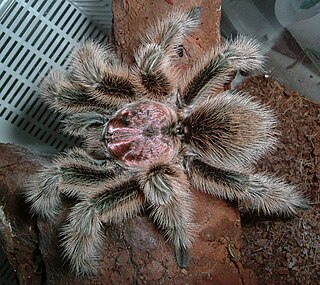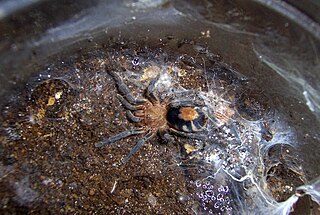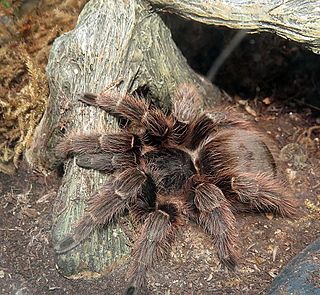
Avicularia is a genus of the family Theraphosidae containing various species of tarantulas. The genus is native to tropical Central and South America. Each species in the genus has very distinguishable pink foot pads.

The Brazilian whiteknee tarantula is a species of tarantula from Brazil that is commonly kept as a pet.

Lasiodora parahybana, the Brazilian salmon pink bird-eating tarantula, also simply known as the salmon pink or LP, is a tarantula from north-eastern Brazil and considered to be the third largest tarantula in the world.

Grammostola is a genus of South American tarantulas that was first described by Eugène Louis Simon in 1892. These medium to large sized spiders are native to tropical South America, and are usually brown in color, with pinkish or orangish-red hairs. The very docile Chilean rose tarantulas are popular as a beginner's spider among tarantula enthusiasts.
Cândido Firmino de Mello-Leitão was a Brazilian zoologist who is considered the founder of Arachnology in South America, publishing 198 papers on the taxonomy of Arachnida. He was also involved with education, writing high-school textbooks, and contributed to biogeography, with essays on the distribution of Arachnida in the South American continent.
Arachnotermes is a genus of jumping spiders. Its sole described species, Arachnotermes termitophilus, is only found in Brazil.

Grammostola pulchra is a species of tarantula, native to Brazil. It is known for its solid black body, which makes it an appealing tarantula for the pet trade.

Phormictopus is a genus of spiders in the family Theraphosidae (tarantulas) that occurs in the West Indies, mainly Cuba and Hispaniola, with three species probably misplaced in this genus found in Brazil and Argentina.

Tarantulas comprise a group of large and often ″hairy″ spiders of the family Theraphosidae. Currently, about 1,000 species have been identified. The term tarantula is usually used to describe members of the family Theraphosidae, although many other members of the same infraorder (Mygalomorphae) are commonly referred to as "tarantulas" or "false tarantulas". Some of the more common species have become popular in the exotic pet trade. Many New World species kept as pets have urticating hairs that can cause irritation to the skin, and in extreme cases, cause damage to the eyes.

Cyriocosmus is a genus of tarantulas that was first described by Eugène Louis Simon in 1903.

Acanthoscurria is a genus of tarantulas that was first described by Anton Ausserer in 1871.

Typhochlaena seladonia is a species of aviculariine tarantula, and is the type species of the genus Typhochlaena. It is unique as an arboreal spider that constructs trapdoors in the bark of trees.

Lasiodora is a genus of tarantulas that was first described by Ludwig Carl Christian Koch in 1850. They are often very large; body lengths of up to 25 centimetres (9.8 in), including the legs, are not unusual.

Eupalaestrus is a genus of South American tarantulas that was first described by Reginald Innes Pocock in 1901.
Plesiopelma is a genus of South American tarantulas that was first described by Reginald Innes Pocock in 1901.
Proshapalopus is a genus of South American tarantulas that was first described by Cândido Firmino de Mello-Leitão in 1923.

Avicularia juruensis is a species of spider in the family Theraphosidae, found in South America. Avicularia urticans was brought into synonymy in 2017. It has been given the English name Amazonian pink toe spider. Under the synonym Avicularia urticans, it is also known as the Peruvian pinktoe tarantula. It is a large mygalomorph spider, with a maximum body length over 30 mm (1.2 in) and the longest fully extended leg about 60 mm (2.4 in). Like other species in the genus Avicularia, specimens under this name are sold as pets, although their identity has not been confirmed by taxonomic studies.
Titidius is a genus of spiders in the family Thomisidae. It was first described in 1895 by Eugène Simon. As of 2017, it contains 20 species.
Xenoctenidae is a family of araneomorph spiders separated from Miturgidae in 2017.













